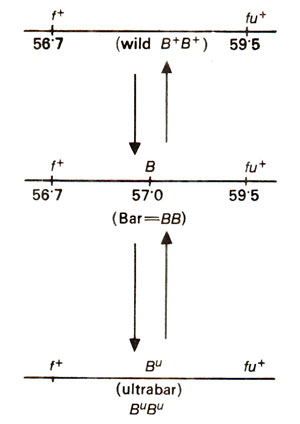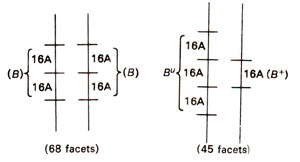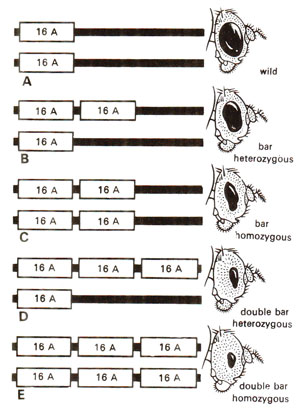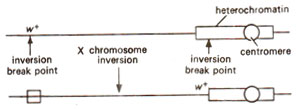Gene vs allele : A new concept of allelomorphism
Position effect
It was shown early in the present century that due to shift of loci from one position to another, or due to shift of another segment in vicinity of a locus, expression changes. This will be illustrated by following two examples.




 Bar eye in
Bar eye in
Drosophila. In 1925, Sturtevant published results of his study on analysis of Bar eye mutant in Drosophila. It was shown that it was a semi-dominant mutation leading to reduction in number of facets from 779 in wild type (B+/B+)to 358 in heterozygote (B+IB)and to 68 in homozygote dominant (B/B). From homozygous for Bar eye (B/B), mutations to wild type occurred at a frequency of one in 1600, and mutation to an extreme type known as ultrabar (with only 24 facets) also occurred, although with a lower frequency (Fig. 14.5). Pure ultrabar cultures (BU/BU)could also be established. Ultrabar also gave rise to wild type eye with the same rate with which ultrabar was obtained from them. It was observed by Sturtevant that frequency of these events was much higher than what was expected due to spontaneous mutations. Therefore, Sturtevant had to seek an alternative explanation. He formulated a hypothesis and confirmed that new types arose due to unequal crossing over in the region of Bar locus. The technique used for confirming unequal crossing over, involved use of marker genes on either side of Bar locus, so that if crossing over occurred, then these marker genes on either side of Bar locus would also recombine, and will prove the occurrence of recombination. As shown in Figure 14.6, asymmetric pairing of homologous chromosomes may lead to unequal crossing over, which is evident from recombined marker genes (forked bristles = f; fused veins = fu). For instance, fB +/+ B fu, when test crossed with fBfu/fBfu, could give rise to four types
Sturtevant also demonstrated that phenotype of flies with two bar genes on one chromosome and none on the other (double bar heterozygous), was different from those with one bar gene on each of the two chromosomes (Figs. 14.7, 14.8). This indicates that position of gene with respect to adjacent regions also influences its expression. This was called position effect. Later C.B. Bridges and his group, through a study of salivary gland chromosomes demonstrated cytologically that Bar character was associated with a repeat of 16A region in X-chromosome (Fig. 14.8) and that ultrabar (double bar) had two such repeats in the same region.
The following conclusions can be made from this work : first that gene is not a point, but has its dimensions and that its alleles may differ in size; second, that alleles of a gene or locus may recombine with each other, producing new combinations and third, that phenotypes of a heterozygote in cis configuration (for instance + +/a1a2)and that of a heterozygote in trans configuration (a1 +/+ a2)may differ due to position effect.
Variegated position effect. Another kind of position effect can be illustrated with the help of an example of eye colour in Drosophila. White eye locus is present on X chromosome near tip of the end away from centromere. Further, centromere is flanked on either side with heterochromatin (inert and more condensed chromatin material relative to euchromatin, which is active and less condensed), the remaining region being largely euchromatic, so that white eye locus lies in euchromatin and quite away from heterochromatin. It was shown that when wild type allele of white eye locus i.e. W+, responsible for red eye colour, is transposed to a region near heterochromatin, a mottling of eye is observed (Fig. 14.9). Mottling means that some facets are wild type and some are white giving a variegated appearance. Variegation effects can also be observed, if a gene originally located near heterochromatin is transferred to a position away from it. Such changes in position of genes can result due to structural changes like inversions or translocations in chromosomes.





It was shown early in the present century that due to shift of loci from one position to another, or due to shift of another segment in vicinity of a locus, expression changes. This will be illustrated by following two examples.

Fig. 14.5. Position effect, due to duplication at bar locus, on the two sides of which genes f+ (wild allele for forked bristles) and fu+ (wild allele for fused veins) are shown.

Fig. 14.6. Appearance of ultrabar and wild from bar eyed Drosophila, due to unequal crossing over. The evidence for crossing over was available due to recombination in f(forked bristles) and fu (fused veins) genes on the two sides of bar locus (B). (B+)* mean, no bar gene (B) is present or that only one dose of I6A region is found.

Fig. 14.7. The difference in phenotypes, between homozygous bar and heterozygous ultrabar, although in each case number of 16A segments is same. This illustrates position effect (also see Fig. 14.8).

Fig. 14.8. Different arrangements of segment 16A on X-chromosomes in female Drosophila and resulting phenotypes, showing position effect.

Fig. 14.9. Transposition of W+ due to inversion from a distal region to a region proximal to heterochromatin on X-chromosome in Drosophila. This leads to variegated position effect.
Drosophila. In 1925, Sturtevant published results of his study on analysis of Bar eye mutant in Drosophila. It was shown that it was a semi-dominant mutation leading to reduction in number of facets from 779 in wild type (B+/B+)to 358 in heterozygote (B+IB)and to 68 in homozygote dominant (B/B). From homozygous for Bar eye (B/B), mutations to wild type occurred at a frequency of one in 1600, and mutation to an extreme type known as ultrabar (with only 24 facets) also occurred, although with a lower frequency (Fig. 14.5). Pure ultrabar cultures (BU/BU)could also be established. Ultrabar also gave rise to wild type eye with the same rate with which ultrabar was obtained from them. It was observed by Sturtevant that frequency of these events was much higher than what was expected due to spontaneous mutations. Therefore, Sturtevant had to seek an alternative explanation. He formulated a hypothesis and confirmed that new types arose due to unequal crossing over in the region of Bar locus. The technique used for confirming unequal crossing over, involved use of marker genes on either side of Bar locus, so that if crossing over occurred, then these marker genes on either side of Bar locus would also recombine, and will prove the occurrence of recombination. As shown in Figure 14.6, asymmetric pairing of homologous chromosomes may lead to unequal crossing over, which is evident from recombined marker genes (forked bristles = f; fused veins = fu). For instance, fB +/+ B fu, when test crossed with fBfu/fBfu, could give rise to four types
- ultrabar, forked bristles and fused veins (fB B fu)
- wild type for eye, bristles and veins (+ B+ +)
- wild type eye, forked bristles and fused veinsifB+fu)
- ultrabar, but wild type bristles and veins (+ BB +)
Sturtevant also demonstrated that phenotype of flies with two bar genes on one chromosome and none on the other (double bar heterozygous), was different from those with one bar gene on each of the two chromosomes (Figs. 14.7, 14.8). This indicates that position of gene with respect to adjacent regions also influences its expression. This was called position effect. Later C.B. Bridges and his group, through a study of salivary gland chromosomes demonstrated cytologically that Bar character was associated with a repeat of 16A region in X-chromosome (Fig. 14.8) and that ultrabar (double bar) had two such repeats in the same region.

Fig. 14.5. Position effect, due to duplication at bar locus, on the two sides of which genes f+ (wild allele for forked bristles) and fu+ (wild allele for fused veins) are shown.

Fig. 14.6. Appearance of ultrabar and wild from bar eyed Drosophila, due to unequal crossing over. The evidence for crossing over was available due to recombination in f(forked bristles) and fu (fused veins) genes on the two sides of bar locus (B). (B+)* mean, no bar gene (B) is present or that only one dose of I6A region is found.

Fig. 14.7. The difference in phenotypes, between homozygous bar and heterozygous ultrabar, although in each case number of 16A segments is same. This illustrates position effect (also see Fig. 14.8).

Fig. 14.8. Different arrangements of segment 16A on X-chromosomes in female Drosophila and resulting phenotypes, showing position effect.

Fig. 14.9. Transposition of W+ due to inversion from a distal region to a region proximal to heterochromatin on X-chromosome in Drosophila. This leads to variegated position effect.




